Challenges and Advancement of Blue III-Nitride Vertical-Cavity Surface-Emitting Lasers
Abstract
:1. Introduction
2. Category of III-Nitride VCSELs
3. Novel Carrier Aperture Designs
4. Polarization Control of III-Nitride VCSEL
5. Outlook of III-Nitride VCSEL Research
Author Contributions
Funding
Institutional Review Board Statement
Informed Consent Statement
Data Availability Statement
Acknowledgments
Conflicts of Interest
References
- Nakamura, S.; Pearton, S.; Fasol, G. The Blue Laser Diode; Springer: Berlin/Heidelberg, Germany, 2000; ISBN 978-3-642-08579-6. [Google Scholar]
- Nakamura, S.; Senoh, M.; Nagahama, S.; Iwasa, N.; Yamada, T.; Matsushita, T.; Kiyoku, H.; Kiyoku, H.; Sugimoto, Y.S.Y. InGaN-Based Multi-Quantum-Well-Structure Laser Diodes. J. Jpn. Appl. Phys. 1996, 35, L74. [Google Scholar] [CrossRef]
- Nakamura, S.; Senoh, M.; Nagahama, S.-I.; Iwasa, N.; Yamada, T.; Matsushita, T.; Kiyoku, H.; Sugimoto, Y.; Kozaki, T.; Umemoto, H.; et al. InGaN/GaN/AlGaN-based laser diodes with modulation-doped strained-layer superlattices grown on an epitaxially laterally overgrown GaN substrate. Appl. Phys. Lett. 1998, 72, 211–213. [Google Scholar] [CrossRef] [Green Version]
- Naniwae, K.; Itoh, S.; Amano, H.; Itoh, K.; Hiramatsu, K.; Akasaki, I. Growth of single crystal GaN substrate using hydride vapor phase epitaxy. J. Cryst. Growth 1990, 99, 381–384. [Google Scholar] [CrossRef]
- Motoki, K.; Okahisa, T.; Matsumoto, N.; Matsushima, M.; Kimura, H.; Kasia, H.; Takemoto, K.; Uematsu, K.; Hirano, T.; Nakayama, M.; et al. Preparation of Large Freestanding GaN Substrates by Hydride Vapor Phase Epitaxy Using GaAs as a Starting Substrate. Appl. Phys. 2001, 40, L140. [Google Scholar] [CrossRef]
- Golan, Y.; Wu, X.H.; Speckb, J.S.; Vaudoc, R.P.; Phanse, V.M. Morphology and microstructural evolution in the early stages of hydride vapor phase epitaxy of GaN on sapphire. Appl. Phys. Lett. 1998, 73, 3090. [Google Scholar] [CrossRef]
- Tavernier, P.R.; Etzkorn, E.V.; Wang, Y.; Clarke, D. Two-step growth of high-quality GaN by hydride vapor-phase epitaxy. Appl. Phys. Lett. 2000, 77, 1804. [Google Scholar] [CrossRef]
- Kamikawa, T.; Kawaguchi, Y.; Vaccaro, P.O.; Ito, S.; Kawanishi, H. Highly reliable 500 mW laser diodes with epitaxially grown AlON coating for high-density optical storage. Appl. Phys. Lett. 2009, 95, 031106. [Google Scholar] [CrossRef]
- König, H.; Lell, A.; Ali, M.; Stojetz, B.; Eichler, C.; Peter, M.; Löffler, A.; Strauss, U.; Baumann, M.; Balck, A.; et al. Blue 450 nm high power semiconductor continuous wave laser bars exceeding rollover output power of 80 W. High. Power Diode Laser Technol. XVI 2018, 10514, 1051402. [Google Scholar] [CrossRef]
- Murayama, M.; Nakayama, Y.; Yamazaki, K.; Hoshina, Y.; Watanabe, H.; Fuutagawa, N.; Kawanishi, H.; Uemura, T.; Narui, H. Watt-Class Green (530 nm) and Blue (465 nm) Laser Diodes. Phys. Status Solidi (A) 2017, 215, 1700513. [Google Scholar] [CrossRef]
- Higuchi, Y.; Omae, K.; Matsumura, H.; Mukai, T. Room-Temperature CW Lasing of a GaN-Based Vertical-Cavity Surface-Emitting Laser by Current Injection. Appl. Phys. Express 2008, 1, 121102. [Google Scholar] [CrossRef]
- Lu, T.-C.; Kao, C.-C.; Kuo, H.-C.; Huang, G.-S.; Wang, S.-C. CW lasing of current injection blue GaN-based vertical cavity surface emitting laser. Appl. Phys. Lett. 2008, 92, 141102. [Google Scholar] [CrossRef]
- Strite, S. GaN, AlN, and InN: A review. J. Vac. Sci. Technol. B Microelectron. Nanometer Struct. 1992, 10, 1237–1266. [Google Scholar] [CrossRef]
- Ambacher, O.; Dimitrov, R.; Stutzmann, M.; Foutz, B.E.; Murphy, M.J.; Smart, J.A.; Shealy, J.R.; Weimann, N.G.; Chu, K.; Chumbes, M.; et al. Role of Spontaneous and Piezoelectric Polarization Induced Effects in Group-III Nitride Based Hetero-structures and Devices. Phys. Status Solidi 1999, 216, 381. [Google Scholar] [CrossRef]
- Bernardini, F.; Fiorentini, V.; Vanderbilt, D. Spontaneous polarization and piezoelectric constants of III-V nitrides. Phys. Rev. B 1997, 56, R10024–R10027. [Google Scholar] [CrossRef] [Green Version]
- Polian, A.; Grimsditch, M.; Grzegory, I. Elastic constants of gallium nitride. J. Appl. Phys. 1996, 79, 3343–3344. [Google Scholar] [CrossRef]
- Wright, A.F. Elastic properties of zinc-blende and wurtzite AlN, GaN, and InN. J. Appl. Phys. 1997, 82, 2833–2839. [Google Scholar] [CrossRef]
- Feezell, D.F.; Speck, J.S.; DenBaars, S.P.; Nakamura, S. Semipolar 20-2-1 InGaN/GaN Light-Emitting Diodes for High-Efficiency Solid-State Lighting. J. Disp. Technol. 2013, 9, 190. [Google Scholar] [CrossRef]
- Chuang, S.L. Optical gain of strained wurtzite GaN quantum-well lasers. IEEE J. Quantum Electron. 1996, 32, 1791–1800. [Google Scholar] [CrossRef]
- Vehse, M.; Michler, P.; Lange, O.; Röwe, M.; Gutowski, J.; Bader, S.; Lugauer, H.-J.; Brüderl, G.; Weimar, A.; Lell, A.; et al. Optical gain and saturation in nitride-based laser structures. Appl. Phys. Lett. 2001, 79, 1763–1765. [Google Scholar] [CrossRef]
- Cosendey, G.; Castiglia, A.; Rossbach, G.; Carlin, J.-F.; Grandjean, N. Blue monolithic AlInN-based vertical cavity surface emitting laser diode on free-standing GaN substrate. Appl. Phys. Lett. 2012, 101, 151113. [Google Scholar] [CrossRef]
- Furuta, T.; Matsui, K.; Horikawa, K.; Ikeyama, K.; Kozuka, Y.; Yoshida, S.; Akagi, T.; Takeuchi, T.; Kamiyama, S.; Iwaya, M.; et al. Room-temperature CW operation of a nitride-based vertical-cavity surface-emitting laser using thick GaInN quantum wells. Jpn. J. Appl. Phys. 2016, 55, 05FJ11. [Google Scholar] [CrossRef]
- Ikeyama, K.; Kozuka, Y.; Matsui, K.; Yoshida, S.; Akagi, T.; Akatsuka, Y.; Koide, N.; Takeuchi, T.; Kamiyama, S.; Iwaya, M.; et al. Room-temperature continuous-wave operation of GaN-based vertical-cavity surface-emitting lasers with n-type conducting AlInN/GaN distributed Bragg reflectors. Appl. Phys. Express 2016, 9, 102101. [Google Scholar] [CrossRef]
- Hayashi, N.; Ogimoto, J.; Matsui, K.; Furuta, T.; Akagi, T.; Iwayama, S.; Takeuchi, T.; Kamiyama, S.; Iwaya, M.; Akasaki, I. A GaN-Based VCSEL with a Convex Structure for Optical Guiding. Phys. Status Solidi (A) 2018, 215, 1700648. [Google Scholar] [CrossRef] [Green Version]
- Akagi, T.; Kozuka, Y.; Ikeyama, K.; Iwayama, S.; Kuramoto, M.; Saito, T.; Tanaka, T.; Takeuchi, T.; Kamiyama, S.; Iwaya, M.; et al. High-quality AlInN/GaN distributed Bragg reflectors grown by metalorganic vapor phase epitaxy. Appl. Phys. Express 2020, 13, 125504. [Google Scholar] [CrossRef]
- Matsui, K.; Kozuka, Y.; Ikeyama, K.; Horikawa, K.; Furuta, T.; Akagi, T.; Takeuchi, T.; Kamiyama, S.; Iwaya, M.; Akasaki, I. GaN-based vertical cavity surface emitting lasers with periodic gain structures. Jpn. J. Appl. Phys. 2016, 55, 05FJ08. [Google Scholar] [CrossRef]
- Bi, W.; Kuo, H.-C.; Ku, P.-C.; Shen, B. Handbook of GaN Semiconductor Materials and Devices; CRC Press: Boca Raton, FL, USA, 2017. [Google Scholar] [CrossRef]
- Hsieh, D.H.; Tzou, A.J.; Kao, T.S.; Lai, F.I.; Lin, D.W.; Lin, B.C.; Lu, T.C.; Lai, W.C.; Chen, C.H.; Kuo, H.C. Improved carrier injection in GaN-based VCSEL via AlGaN/GaN multiple quantum barrier electron blocking layer. Opt. Express 2015, 23, 27145–27151. [Google Scholar] [CrossRef] [PubMed]
- Chang, T.-C.; Kuo, S.-Y.; Lian, J.-T.; Hong, K.-B.; Wang, S.-C.; Lu, T.-C. High-temperature operation of GaN-based vertical-cavity surface-emitting lasers. Appl. Phys. Express 2017, 10, 112101. [Google Scholar] [CrossRef]
- Chang, T.-C.; Hashemi, E.; Hong, K.-B.; Bengtsson, J.; Gustavsson, J.; Haglund, A.; Lu, T.-C. Electrically Injected GaN-Based Vertical-Cavity Surface-Emitting Lasers with TiO2 High-Index-Contrast Grating Reflectors. ACS Photon. 2020, 7, 861–866. [Google Scholar] [CrossRef]
- Chang, T.-C.; Kuo, S.-Y.; Lian, J.-T.; Hong, K.-B.; Lu, T.-C.; Wang, S.-C. GaN-based vertical-cavity surface-emitting lasers operating at high temperature. In Proceedings of the 2017 22nd Microoptics Conference (MOC), Tokyo, Japan, 19–22 November 2017. [Google Scholar]
- Omae, K.; Higuchi, Y.; Nakagawa, K.; Matsumura, H.; Mukai, T. Improvement in Lasing Characteristics of GaN-based Vertical-Cavity Surface-Emitting Lasers Fabricated Using a GaN Substrate. Appl. Phys. Express 2009, 2, 052101. [Google Scholar] [CrossRef]
- Kasahara, D.; Morita, D.; Kosugi, T.; Nakagawa, K.; Kawamata, J.; Higuchi, Y.; Matsumura, H.; Mukai, T. Demonstration of Blue and Green GaN-Based Vertical-Cavity Surface-Emitting Lasers by Current Injection at Room Temperature. Appl. Phys. Express 2011, 4, 072103. [Google Scholar] [CrossRef]
- Onishi, T.; Imafuji, O.; Nagamatsu, K.; Kawaguchi, M.; Yamanaka, K.; Takigawa, S. Continuous Wave Operation of GaN Vertical Cavity Surface Emitting Lasers at Room Temperature. IEEE J. Quantum Electron. 2012, 48, 1107–1112. [Google Scholar] [CrossRef]
- Izumi, S.; Fuutagawa, N.; Hamaguchi, T.; Murayama, M.; Kuramoto, M.; Narui, H. Room-temperature continuous-wave operation of GaN-based vertical-cavity surface-emitting lasers fabricated using epitaxial lateral overgrowth. Appl. Phys. Express 2015, 8, 062702. [Google Scholar] [CrossRef]
- Hamaguchi, T.; Fuutagawa, N.; Izumi, S.; Murayama, M.; Narui, H. Milliwatt-class GaN-based blue vertical-cavity surface-emitting lasers fabricated by epitaxial lateral overgrowth. Phys. Status Solidi (A) 2016, 213, 1170–1176. [Google Scholar] [CrossRef]
- Hamaguchi, T.; Tanaka, M.; Mitomo, J.; Nakajima, H.; Ito, M.; Ohara, M.; Kobayashi, N.; Fujii, K.; Watanabe, H.; Satou, S.; et al. Lateral optical confinement of GaN-based VCSEL using an atomically smooth monolithic curved mirror. Sci. Rep. 2018, 8, 10350. [Google Scholar] [CrossRef] [Green Version]
- Hamaguchi, T.; Nakajima, H.; Fuutagawa, N. GaN-based Vertical-Cavity Surface-Emitting Lasers Incorporating Dielectric Distributed Bragg Reflectors. Appl. Sci. 2019, 9, 733. [Google Scholar] [CrossRef] [Green Version]
- Kuramoto, M.; Kobayashi, S.; Akagi, T.; Tazawa, K.; Tanaka, K.; Saito, T.; Takeuchi, T. Enhancement of slope efficiency and output power in GaN-based vertical-cavity surface-emitting lasers with a SiO2-buried lateral index guide. Appl. Phys. Lett. 2018, 112, 111104. [Google Scholar] [CrossRef]
- Kuramoto, M.; Kobayashi, S.; Akagi, T.; Tazawa, K.; Tanaka, K.; Saito, T.; Takeuchi, T. High-output-power and high-temperature operation of blue GaN-based vertical-cavity surface-emitting laser. Appl. Phys. Express 2018, 11, 112101. [Google Scholar] [CrossRef]
- Kuramoto, M.; Kobayashi, S.; Tazawa, K.; Tanaka, K.; Akagi, T.; Saito, T. In-phase supermode operation in GaN-based vertical-cavity surface-emitting laser. Appl. Phys. Lett. 2019, 115, 041101. [Google Scholar] [CrossRef]
- Kuramoto, M.; Kobayashi, S.; Akagi, T.; Tazawa, K.; Tanaka, K.; Nakata, K.; Saito, T. Watt-class blue vertical-cavity surface-emitting laser arrays. Appl. Phys. Express 2019, 12, 091004. [Google Scholar] [CrossRef] [Green Version]
- Kuramoto, M.; Kobayashi, S.; Akagi, T.; Tazawa, K.; Tanaka, H.; Takeuchi, T. Nano-height cylindrical waveguide in GaN-based vertical-cavity surface-emitting lasers. Appl. Phys. Express 2020, 13, 082005. [Google Scholar] [CrossRef]
- Holder, C.; Speck, J.S.; Denbaars, S.; Nakamura, S.; Feezell, D. Demonstration of Nonpolar GaN-Based Vertical-Cavity Surface-Emitting Lasers. Appl. Phys. Express 2012, 5, 092104. [Google Scholar] [CrossRef]
- Leonard, J.T.; Cohen, D.A.; Yonkee, B.P.; Farrell, R.M.; Margalith, T.; Lee, S.G.; DenBaars, S.P.; Speck, J.S.; Nakamura, S. Nonpolar III-nitride vertical-cavity surface-emitting lasers incorporating an ion implanted aperture. Appl. Phys. Lett. 2015, 107, 011102. [Google Scholar] [CrossRef]
- Leonard, J.T.; Young, E.C.; Yonkee, B.P.; Cohen, D.A.; Margalith, T.; DenBaars, S.P.; Speck, J.S.; Nakamura, S. Demonstration of a III-nitride vertical-cavity surface-emitting laser with a III-nitride tunnel junction intracavity contact. Appl. Phys. Lett. 2015, 107, 091105. [Google Scholar] [CrossRef]
- Holder, C.O.; Leonard, J.T.; Farrell, R.M.; Cohen, D.A.; Yonkee, B.; Speck, J.S.; Denbaars, S.; Nakamura, S.; Feezell, D.F. Nonpolar III-nitride vertical-cavity surface emitting lasers with a polarization ratio of 100% fabricated using photoelectrochemical etching. Appl. Phys. Lett. 2014, 105, 031111. [Google Scholar] [CrossRef]
- Leonard, J.T.; Yonkee, B.P.; Cohen, D.A.; Megalini, L.; Lee, S.G.; Speck, J.S.; DenBaars, S.P.; Nakamura, S. Nonpolar III-nitride vertical-cavity surface-emitting laser with a photoelectrochemically etched air-gap aperture. Appl. Phys. Lett. 2016, 108, 031111. [Google Scholar] [CrossRef]
- Forman, C.A.; Lee, S.; Young, E.C.; Kearns, J.A.; Cohen, D.A.; Leonard, J.T.; Margalith, T.; DenBaars, S.P.; Nakamura, S. Continuous-wave operation of m-plane GaN-based vertical-cavity surface-emitting lasers with a tunnel junction intracavity contact. Appl. Phys. Lett. 2018, 112, 111106. [Google Scholar] [CrossRef]
- Lee, S.; Forman, C.A.; Lee, C.; Kearns, J.; Young, E.C.; Leonard, J.T.; Cohen, D.A.; Speck, J.S.; Nakamura, S.; Denbaars, S. GaN-based vertical-cavity surface-emitting lasers with tunnel junction contacts grown by metal-organic chemical vapor deposition. Appl. Phys. Express 2018, 11, 062703. [Google Scholar] [CrossRef]
- Mishkat-Ul-Masabih, S.M.; Aragon, A.A.; Monavarian, M.; Luk, T.S.; Feezell, D.F. Electrically injected nonpolar GaN-based VCSELs with lattice-matched nanoporous distributed Bragg reflector mirrors. Appl. Phys. Express 2019, 12, 036504. [Google Scholar] [CrossRef]
- Liu, W.-J.; Hu, X.-L.; Ying, L.-Y.; Zhang, J.-Y.; Zhang, B.-P. Room temperature continuous wave lasing of electrically injected GaN-based vertical cavity surface emitting lasers. Appl. Phys. Lett. 2014, 104, 251116. [Google Scholar] [CrossRef]
- Xu, R.; Mei, Y.; Xu, H.; Yang, T.-R.; Ying, L.-Y.; Zheng, Z.-W.; Long, H.; Zhang, B.-P.; Liu, J. Effects of Lateral Optical Confinement in GaN VCSELs With Double Dielectric DBRs. IEEE Photon. J. 2020, 12, 1–8. [Google Scholar] [CrossRef]
- Westbergh, P.; Gustavsson, J.S.; Haglund, Å.; Skold, M.; Joel, A.; Larsson, A. High-Speed, Low-Current-Density 850 nm VCSELs. IEEE J. Sel. Top. Quantum Electron. 2009, 15, 694–703. [Google Scholar] [CrossRef]
- Khan, Z.; Ledentsov, N.; Chorchos, L.; Shih, J.-C.; Chang, Y.-H.; Shi, J.-W. Single-Mode 940 nm VCSELs With Narrow Divergence Angles and High-Power Performances for Fiber and Free-Space Optical Communications. IEEE Access 2020, 8, 72095–72101. [Google Scholar] [CrossRef]
- Chaqmaqchee, F.; Lott, J. Impact of oxide aperture diameter on optical output power, spectral emission, and bandwidth for 980 nm VCSELs. OSA Contin. 2020, 3, 2602. [Google Scholar] [CrossRef]
- Sirbu, A.; Iakovelv, V.; Mereuta, A.; Caliman, A.; Suruceanu, G.; Kapon, E. Wafer-fused heterostructures: Application to vertical cavity surface-emitting lasers emitting in the 1310 nm band. Semicond. Sci. Technol. 2010, 26, 014016. [Google Scholar] [CrossRef]
- Muller, M.; Hofmann, W.; Grundl, T.; Horn, M.; Wolf, P.; Nagel, R.D.; Ronneberg, E.; Bohm, G.; Bimberg, D.; Amann, M.-C. 1550-nm High-Speed Short-Cavity VCSELs. IEEE J. Sel. Top. Quantum Electron. 2011, 17, 1158–1166. [Google Scholar] [CrossRef]
- Alam, S.N.; Zubialevich, V.Z.; Ghafary, B.; Parbrook, P.J. Bandgap and refractive index estimates of InAlN and related nitrides across their full composition ranges. Sci. Rep. 2020, 10, 16205. [Google Scholar] [CrossRef]
- Takeuchi, K.; Adachi, S.; Ohtsuka, K. Optical properties of AlxGa1−xN alloy. J. Appl. Phys. 2010, 107, 023306. [Google Scholar] [CrossRef]
- Antoinevincent, N.; Natali, F.; Mihailovic, M.; Vasson, A.M.; Leymarie, J.; Disseix, P.; Byrne, D.; Semond, F.; Massies, J. Determination of the refractive indices of AlN, GaN, and AlxGa1−xN grown on (111)Si substrates. J. Appl. Phys. 2003, 93, 5222–5226. [Google Scholar] [CrossRef]
- Yu, G.; Wang, G.; Ishikawa, H.; Umeno, M.; Soga, T.; Egawa, T.; Watanabe, J.; Jimbo, T. Optical properties of wurtzite structure GaN on sapphire around fundamental absorption edge (0.78–4.77 eV) by spectroscopic ellipsometry and the optical transmission method. Appl. Phys. Lett. 1997, 70, 3209–3211. [Google Scholar] [CrossRef]
- Hashemi, E.; Bengtsson, J.; Gustavsson, J.; Stattin, M.; Cosendey, G.; Grandjean, N.; Haglund, A. Analysis of structurally sensitive loss in GaN-based VCSEL cavities and its effect on modal discrimination. Opt. Express 2014, 22, 411–426. [Google Scholar] [CrossRef] [Green Version]
- Redondo-Cubero, A.; Lorenz, K.; Gago, R.; Franco, N.; Poisson, M.-A.D.F.; Alves, E.; Muñoz, E. Depth-resolved analysis of spontaneous phase separation in the growth of lattice-matched AlInN. J. Phys. D Appl. Phys. 2010, 43, 055406. [Google Scholar] [CrossRef]
- Zhou, L.; Smith, D.J.; McCartney, M.R.; Katzer, D.S.; Storm, D.F. Observation of vertical honeycomb structure in InAlN/GaNInAlN∕GaN heterostructures due to lateral phase separation. Appl. Phys. Lett. 2007, 90, 081917. [Google Scholar] [CrossRef]
- Perillat-Merceroz, G.; Cosendey, G.; Carlin, J.-F.; Butte, R.; Grandjean, N. Intrinsic degradation mechanism of nearly lattice-matched InAlN layers grown on GaN substrates. J. Appl. Phys. 2013, 113, 063506. [Google Scholar] [CrossRef]
- Lobanova, A.; Segal, A.; Yakovlev, E.; Talalaev, R. AlInN MOVPE: Growth chemistry and analysis of trends. J. Cryst. Growth 2012, 352, 199–202. [Google Scholar] [CrossRef]
- Berger, C.; Dadgar, A.; Bläsing, J.; Lesnik, A.; Veit, P.; Schmidt, G.; Hempel, T.; Christen, J.; Krost, A.; Strittmatter, A. Growth of AlInN/GaN distributed Bragg reflectors with improved interface quality. J. Cryst. Growth 2015, 414, 105–109. [Google Scholar] [CrossRef]
- Gadanecz, A.; Bläsing, J.; Dadgar, A.; Hums, C.; Krost, A. Thermal stability of metal organic vapor phase epitaxy grown AlInN. Appl. Phys. Lett. 2007, 90, 221906. [Google Scholar] [CrossRef]
- Cosendey, G.; Carlin, J.-F.; Kaufmann, N.A.K.; Butte, R.; Grandjean, N. Strain compensation in AlInN/GaN multilayers on GaN substrates: Application to the realization of defect-free Bragg reflectors. Appl. Phys. Lett. 2011, 98, 181111. [Google Scholar] [CrossRef]
- Carlin, J.-F.; Ilegems, M. High-quality AlInN for high index contrast Bragg mirrors lattice matched to GaN. Appl. Phys. Lett. 2003, 83, 668–670. [Google Scholar] [CrossRef]
- Chen, D.; Xiao, H.; Han, J. Nanopores in GaN by electrochemical anodization in hydrofluoric acid: Formation and mechanism. J. Appl. Phys. 2012, 112, 064303. [Google Scholar] [CrossRef]
- Zhang, C.; Park, S.H.; Chen, D.; Lin, D.-W.; Xiong, W.; Kuo, H.-C.; Lin, C.-F.; Cao, H.; Han, J. Mesoporous GaN for Photonic Engineering—Highly Reflective GaN Mirrors as an Example. ACS Photon. 2015, 2, 980–986. [Google Scholar] [CrossRef]
- Lee, S.-M.; Gong, S.-H.; Kang, J.-H.; Ebaid, M.; Ryu, S.-W.; Cho, Y.-H. Optically pumped GaN vertical cavity surface emitting laser with high index-contrast nanoporous distributed Bragg reflector. Opt. Express 2015, 23, 11023–11030. [Google Scholar] [CrossRef] [PubMed]
- Mishkat-Ul-Masabih, S.M.; Luk, T.S.; Monavarian, M.; Feezell, D.F. Polarization-pinned emission of a continuous-wave optically pumped nonpolar GaN-based VCSEL using nanoporous distributed Bragg reflectors. Opt. Express 2019, 27, 9495–9501. [Google Scholar] [CrossRef] [PubMed]
- Stonas, A.R.; Margalith, T.; Denbaars, S.; Coldren, L.A.; Hu, E.L. Development of selective lateral photoelectrochemical etching of InGaN/GaN for lift-off applications. Appl. Phys. Lett. 2001, 78, 1945–1947. [Google Scholar] [CrossRef]
- Haberer, E.; Sharma, R.; Stonas, A.R.; Nakamura, S.; DenBaars, S.P.; Hu, E.L. Removal of thick (>100 nm) InGaN layers for optical devices using band-gap-selective photoelectrochemical etching. Appl. Phys. Lett. 2004, 85, 762. [Google Scholar] [CrossRef]
- Sharma, R.; Haberer, E.; Meier, C.; Hu, E.L.; Nakamura, S. Vertically oriented GaN-based air-gap distributed Bragg reflector structure fabricated using band-gap-selective photoelectrochemical etching. Appl. Phys. Lett. 2005, 87, 051107. [Google Scholar] [CrossRef]
- Chen, L.-R.; Chen, B.-Y.; Kuo, S.-Y.; Hong, K.-B.; Lu, T.-C. Anti-guiding and guiding effects in GaN-based vertical-cavity surface-emitting lasers. AIP Adv. 2020, 10, 025204. [Google Scholar] [CrossRef]
- Park, S.-H. Crystal Orientation Effects on Many-Body Optical Gain of Wurtzite InGaN/GaN Quantum Well Lasers. Jpn. J. Appl. Phys. 2003, 42, L170–L172. [Google Scholar] [CrossRef] [Green Version]
- Park, S.-H.; Ahn, D. Optical polarization characteristics of m-plane InGaN/GaN quantum well structures and comparison with experiment. Appl. Phys. Lett. 2013, 103, 101107. [Google Scholar] [CrossRef]
- Romanov, A.E.; Baker, T.J.; Nakamura, S.; Speck, J.S. ERATO/JST UCSB Group Strain-induced polarization in wurtzite III-nitride semipolar layers. J. Appl. Phys. 2006, 100, 023522. [Google Scholar] [CrossRef] [Green Version]
- Kubota, M.; Okamoto, K.; Tanaka, T.; Ohta, H. Temperature dependence of polarized photoluminescence from nonpolar m-plane InGaN multiple quantum wells for blue laser diodes. Appl. Phys. Lett. 2008, 92, 011920. [Google Scholar] [CrossRef]
- You, S.; Detchprohm, T.; Zhu, M.; Hou, W.; Preble, E.A.; Hanser, D.; Paskova, T.; Wetzel, C. Highly Polarized Green Light Emitting Diode inm-Axis GaInN/GaN. Appl. Phys. Express 2010, 3, 102103. [Google Scholar] [CrossRef] [Green Version]
- Kyono, T.; Yoshizumi, Y.; Enya, Y.; Adachi, M.; Tokuyama, S.; Ueno, M.; Katayama, K.; Nakamura, T. Optical Polarization Characteristics of InGaN Quantum Wells for Green Laser Diodes on Semi-Polar {20\bar21} GaN Substrates. Appl. Phys. Express 2010, 3, 011003. [Google Scholar] [CrossRef]
- Huang, M.C.; Zhou, Y.; Chang-Hasnain, C.J. A surface-emitting laser incorporating a high-index-contrast subwavelength grating. Nat. Photon. 2007, 1, 119–122. [Google Scholar] [CrossRef]
- Mateus, C.F.R.; Huang, M.C.Y.; Chen, L.; Changhasnain, C.J.; Suzuki, Y. Broad-Band Mirror (1.12–1.62 μm) Using a Subwavelength Grating. IEEE Photon. Technol. Lett. 2004, 16, 1676–1678. [Google Scholar] [CrossRef]
- Karagodsky, V.; Sedgwick, F.G.; Chang-Hasnain, C.J. Theoretical analysis of subwavelength high contrast grating reflectors. Opt. Express 2010, 18, 16973–16988. [Google Scholar] [CrossRef]
- Huang, S.-C.; Hong, K.-B.; Li, H.; Lu, T.-C. Metallic subwavelength grating on GaN-based edge emitting lasers. In Proceedings of the 2015 International Conference on Numerical Simulation of Optoelectronic Devices (NUSOD), Taipei, Taiwan, 7–11 September 2015; pp. 135–136. [Google Scholar]
- Chang, T.-C.; Kuo, S.-Y.; Hashemi, E.; Haglund, Å.; Lu, T.-C. Lasing action in GaN-based VCSELs with top high-contrast grating reflectors. In Proceedings of the International Semiconductor Laser Conference (ISLC), Santa Fe, NM, USA, 16–19 September 2018; pp. 1–2. [Google Scholar]
- Chang, T.-C.; Hong, K.-B.; Kuo, S.-Y.; Lu, T.-C. Demonstration of polarization control GaN-based micro-cavity lasers using a rigid high-contrast grating reflector. Sci. Rep. 2019, 9, 13055. [Google Scholar] [CrossRef]
- Siekacz, M.; Muziol, G.; Hajdel, M.; Żak, M.; Nowakowski-Szkudlarek, K.; Turski, H.; Sawicka, M.; Wolny, P.; Feduniewicz-Żmuda, A.; Stanczyk, S.; et al. Stack of two III-nitride laser diodes interconnected by a tunnel junction. Opt. Express 2019, 27, 5784–5791. [Google Scholar] [CrossRef]
- Yonkee, B.P.; Young, E.C.; Lee, C.; Leonard, J.T.; Denbaars, S.; Speck, J.S.; Nakamura, S. Demonstration of a III-nitride edge-emitting laser diode utilizing a GaN tunnel junction contact. Opt. Express 2016, 24, 7816–7822. [Google Scholar] [CrossRef]
- Zhao, Y.; Wu, F.; Huang, C.-Y.; Kawaguchi, Y.; Tanaka, S.; Fujito, K.; Speck, J.S.; Denbaars, S.; Nakamura, S. Suppressing void defects in long wavelength semipolar (202¯1¯) InGaN quantum wells by growth rate optimization. Appl. Phys. Lett. 2013, 102, 091905. [Google Scholar] [CrossRef] [Green Version]
- El-Masry, N.A.; Piner, E.L.; Liu, S.X.; Bedair, S.M. Phase separation in InGaN grown by metalorganic chemical vapor deposition. Appl. Phys. Lett. 1998, 72, 40–42. [Google Scholar] [CrossRef]
- Müller, M.; Smith, G.; Gault, B.; Grovenor, C. Phase separation in thick InGaN layers—A quantitative, nanoscale study by pulsed laser atom probe tomography. Acta Mater. 2012, 60, 4277–4285. [Google Scholar] [CrossRef]
- Hardy, M.T.; Wu, F.; Huang, C.-Y.; Zhao, Y.; Feezell, D.F.; Nakamura, S.; Speck, J.S.; Denbaars, S. Impact of p-GaN Thermal Damage and Barrier Composition on Semipolar Green Laser Diodes. IEEE Photon. Technol. Lett. 2013, 26, 43–46. [Google Scholar] [CrossRef]
- Miyoshi, T.; Masui, S.; Okada, T.; Yanamoto, T.; Kozaki, T.; Nagahama, S.-I.; Mukai, T. 510–515 nm InGaN-Based Green Laser Diodes onc-Plane GaN Substrate. Appl. Phys. Express 2009, 2, 062201. [Google Scholar] [CrossRef]
- Adachi, M.; Yoshizumi, Y.; Enya, Y.; Kyono, T.; Sumitomo, T.; Tokuyama, S.; Takagi, S.; Sumiyoshi, K.; Saga, N.; Ikegami, T.; et al. Low Threshold Current Density InGaN Based 520–530 nm Green Laser Diodes on Semi-Polar {20\bar21} Free-Standing GaN Substrates. Appl. Phys. Express 2010, 3, 121001. [Google Scholar] [CrossRef]
- Frost, T.; Banerjee, A.; Sun, K.; Chuang, S.L.; Bhattacharya, P. InGaN/GaN Quantum Dot Red (λ = 630 nm) Laser. IEEE J. Quantum Electron. 2013, 49, 923–931. [Google Scholar] [CrossRef]
- Huang, C.-Y.; Walde, S.; Tsai, C.-L.; Netzel, C.; Liu, H.-H.; Hagedorn, S.; Wu, Y.-R.; Fu, Y.-K.; Weyers, M.; Sebastian, W. Overcoming the excessive compressive strain in AlGaN epitaxy by introducing high Si-doping in AlN templates. Jpn. J. Appl. Phys. 2020, 59, 070904. [Google Scholar] [CrossRef]
- Dycus, J.H.; Washiyama, S.; Eldred, T.B.; Guan, Y.; Kirste, R.; Mita, S.; Sitar, Z.; Collazo, R.; Lebeau, J.M. The role of transient surface morphology on composition control in AlGaN layers and wells. Appl. Phys. Lett. 2019, 114, 031602. [Google Scholar] [CrossRef]
- Kneissl, M.; Treat, D.W.; Teepe, M.; Miyashita, N.; Johnson, N.M. Ultraviolet AlGaN multiple-quantum-well laser diodes. Appl. Phys. Lett. 2003, 82, 4441–4443. [Google Scholar] [CrossRef]
- Yoshida, H.; Yamashita, Y.; Kuwabara, M.; Kan, H. A 342-nm ultraviolet AlGaN multiple-quantum-well laser diode. Nat. Photon. 2008, 2, 551–554. [Google Scholar] [CrossRef]
- Yoshida, H.; Yamashita, Y.; Kuwabara, M.; Kan, H. Demonstration of an ultraviolet 336 nm AlGaN multiple-quantum-well laser diode. Appl. Phys. Lett. 2008, 93, 241106. [Google Scholar] [CrossRef]
- Zhang, Z.; Kushimoto, M.; Sakai, T.; Sugiyama, N.; Schowalter, L.J.; Sasaoka, C.; Amano, H. A 271.8 nm deep-ultraviolet laser diode for room temperature operation. Appl. Phys. Express 2019, 12, 124003. [Google Scholar] [CrossRef]
- Hjort, F.; Enslin, J.; Cobet, M.; Bergmann, M.A.; Gustavsson, J.; Kolbe, T.; Knauer, A.; Nippert, F.; Häusler, I.; Wagner, M.R.; et al. A 310 nm Optically Pumped AlGaN Vertical-Cavity Surface-Emitting Laser. ACS Photon. 2021, 8, 135–141. [Google Scholar] [CrossRef]
- Zhang, C.; El Afandy, R.T.; Zhang, J.; Chen, S.; Nurmikko, A.; Han, J. Development of nanopore-based near ultraviolet vertical-cavity surface emitting lasers. In Proceedings of the Gallium Nitride Materials and Devices XIV, San Francisco, CA, USA, 4–7 February 2019; International Society for Optics and Photonics: Bellingham, WA, USA, 2019; Volume 10918, p. 109181M. [Google Scholar]
- Liu, Y.-S.; Haq, A.F.M.S.; Mehta, K.; Kao, T.-T.; Wang, S.; Xie, H.; Shen, S.-C.; Yoder, P.D.; Ponce, F.; Detchprohm, T.; et al. Optically pumped vertical-cavity surface-emitting laser at 374.9 nm with an electrically conducting n-type distributed Bragg reflector. Appl. Phys. Express 2016, 9, 111002. [Google Scholar] [CrossRef]
- Yeh, T.-W.; Lin, Y.-T.; Stewart, L.S.; Dapkus, P.D.; Sarkissian, R.; O’Brien, J.D.; Ahn, B.; Nutt, S.R. InGaN/GaN Multiple Quantum Wells Grown on Nonpolar Facets of Vertical GaN Nanorod Arrays. Nano Lett. 2012, 12, 3257–3262. [Google Scholar] [CrossRef]
- Huang, C.-Y.; Tai, T.-Y.; Hong, K.-B.; Kuo, H.-C.; Lu, T.-C. Analysis of Quality Factor Enhancement in the Monolithic InGaN/GaN Nanorod Array. Appl. Sci. 2019, 9, 1295. [Google Scholar] [CrossRef] [Green Version]
- Huang, C.-Y.; Lin, J.-J.; Chang, T.-C.; Liu, C.-Y.; Tai, T.-Y.; Hong, K.-B.; Lu, T.-C.; Kuo, H.-C. Collective Lasing Behavior of Monolithic GaN–InGaN Core–Shell Nanorod Lattice under Room Temperature. Nano Lett. 2017, 17, 6228–6234. [Google Scholar] [CrossRef]
- Huang, C.-Y.; Lin, J.-J.; Chang, T.-C.; Liu, C.-Y.; Dai, T.-Y.; Hong, K.-B.; Lu, T.-C.; Kuo, H.-C. Monolithic GaN-InGaN Core-shell Lasers in Submicron Scale. In Proceedings of the Conference on Lasers and Electro-Optics, San Jose, CA, USA, 14–19 May 2017; The Optical Society: Washington, DC, USA, 2017; p. STh1C.2. [Google Scholar]
- Ra, Y.-H.; Lee, C.-R. Ultracompact display pixels: Tunnel junction nanowire photonic crystal laser. Nano Energy 2021, 84, 105870. [Google Scholar] [CrossRef]
- Deng, H.; Weihs, G.; Snoke, D.; Bloch, J.; Yamamoto, Y. Polariton lasing vs. photon lasing in a semiconductor microcavity. Proc. Natl. Acad. Sci. USA 2003, 100, 15318–15323. [Google Scholar] [CrossRef] [Green Version]
- Schneider, C.; Rahimi-Iman, A.; Kim, N.Y.; Fischer, J.; Savenko, I.; Amthor, M.; Lermer, M.; Wolf, A.; Worschech, L.; Kulakovskii, V.D.; et al. An electrically pumped polariton laser. Nat. Cell Biol. 2013, 497, 348–352. [Google Scholar] [CrossRef]
- Bhattacharya, P.; Xiao, B.; Das, A.; Bhowmick, S.; Heo, J. Solid State Electrically Injected Exciton-Polariton Laser. Phys. Rev. Lett. 2013, 110, 206403. [Google Scholar] [CrossRef]
- Tao, R.; Kamide, K.; Arita, M.; Kako, S.; Arakawa, Y. Room-Temperature Observation of Trapped Exciton-Polariton Emission in GaN/AlGaN Microcavities with Air-Gap/III-Nitride Distributed Bragg Reflectors. ACS Photon. 2016, 3, 1182–1187. [Google Scholar] [CrossRef]
- Ciers, J.; Roch, J.G.; Carlin, J.-F.; Jacopin, G.; Butte, R.; Grandjean, N. Propagating Polaritons in III-Nitride Slab Waveguides. Phys. Rev. Appl. 2017, 7, 034019. [Google Scholar] [CrossRef] [Green Version]
- Ciers, J.; Solnyshkov, D.D.; Callsen, G.; Kuang, Y.; Carlin, J.-F.; Malpuech, G.; Butté, R.; Grandjean, N. Polariton relaxation and polariton nonlinearities in nonresonantly cw-pumped III-nitride slab waveguides. Phys. Rev. B 2020, 102, 155304. [Google Scholar] [CrossRef]
- Bhattacharya, P.; Frost, T.; Deshpande, S.; Baten, Z.; Hazari, A.; Das, A. Room Temperature Electrically Injected Polariton Laser. Phys. Rev. Lett. 2014, 112, 236802. [Google Scholar] [CrossRef]



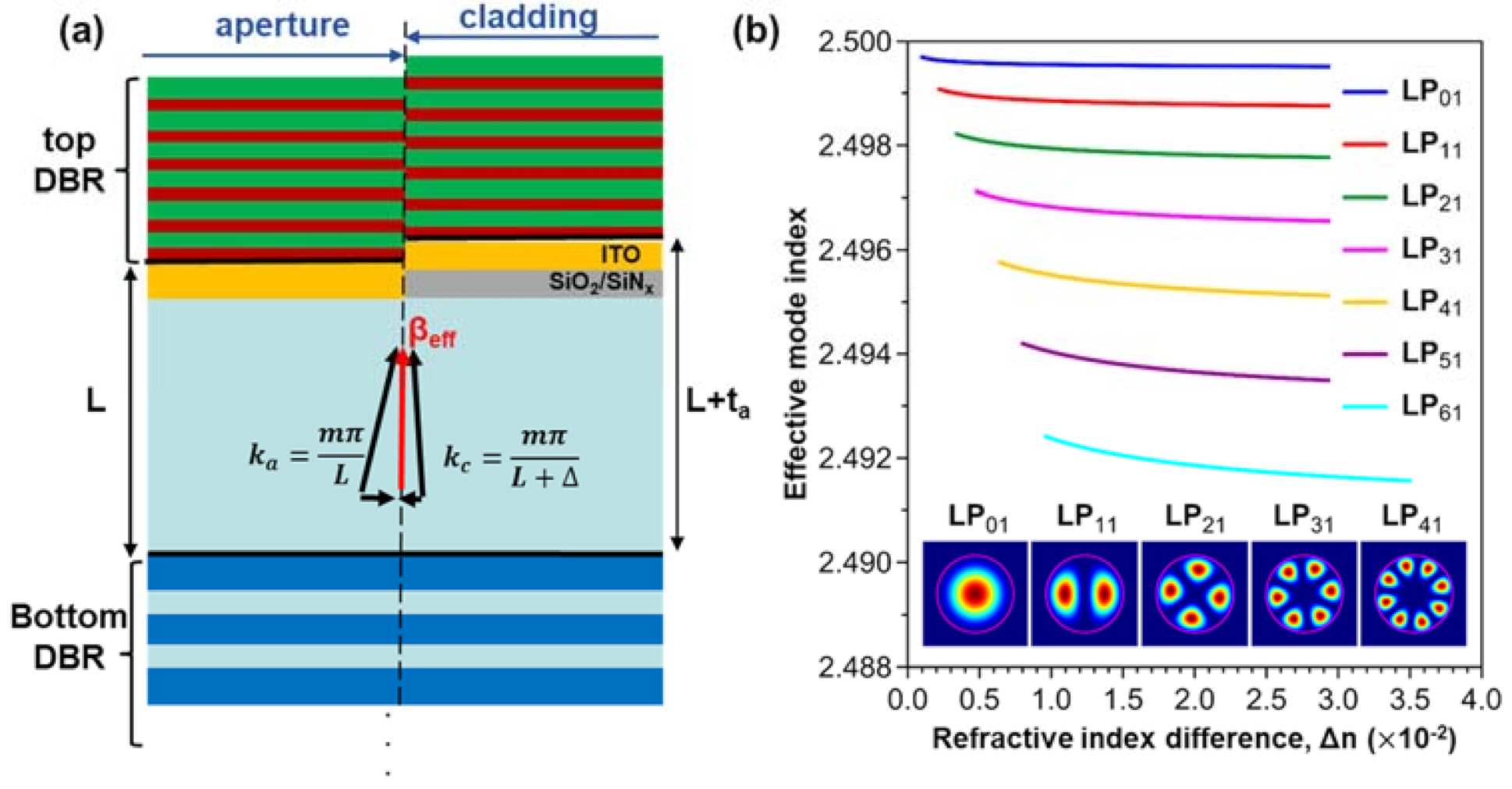
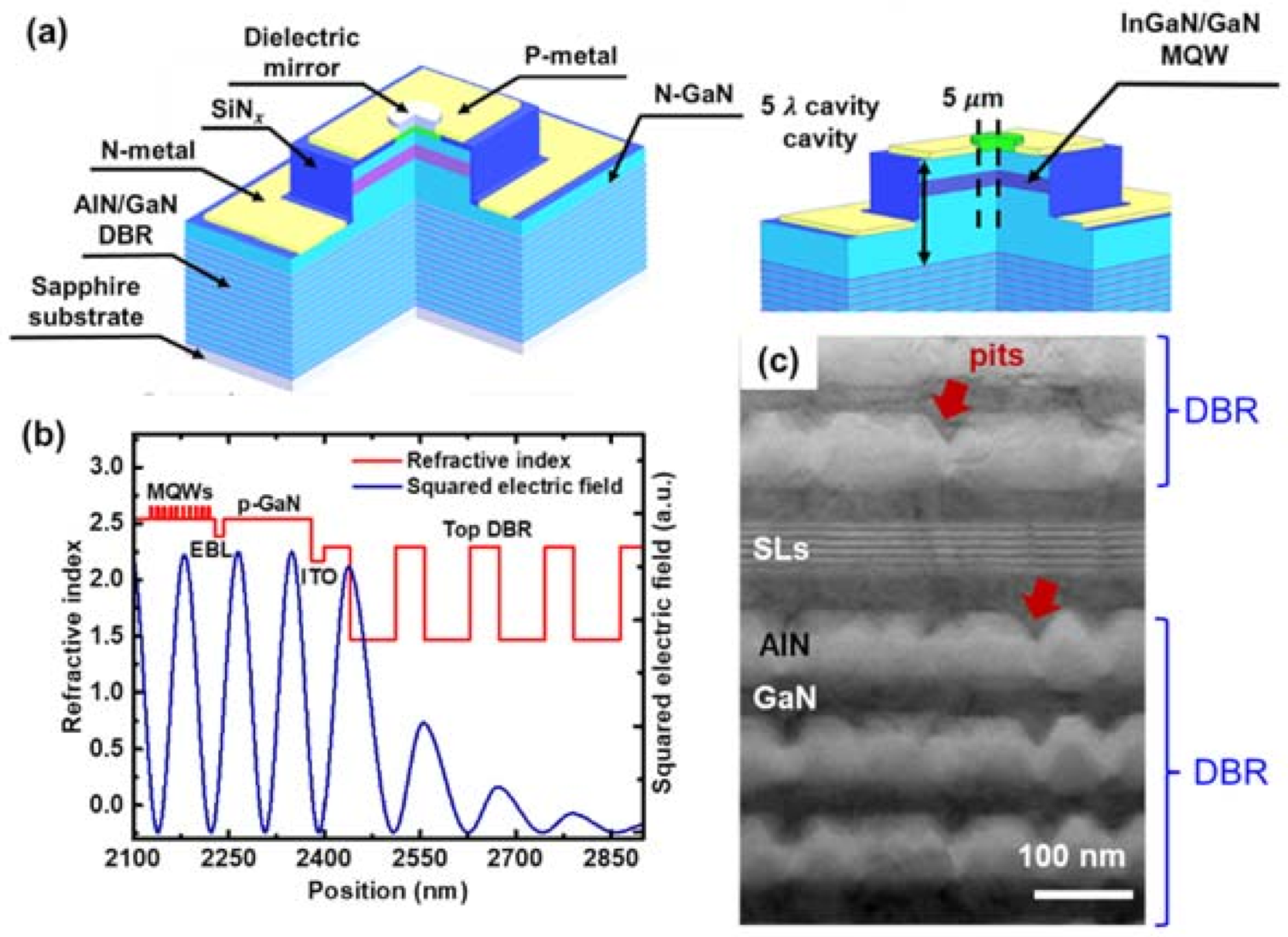
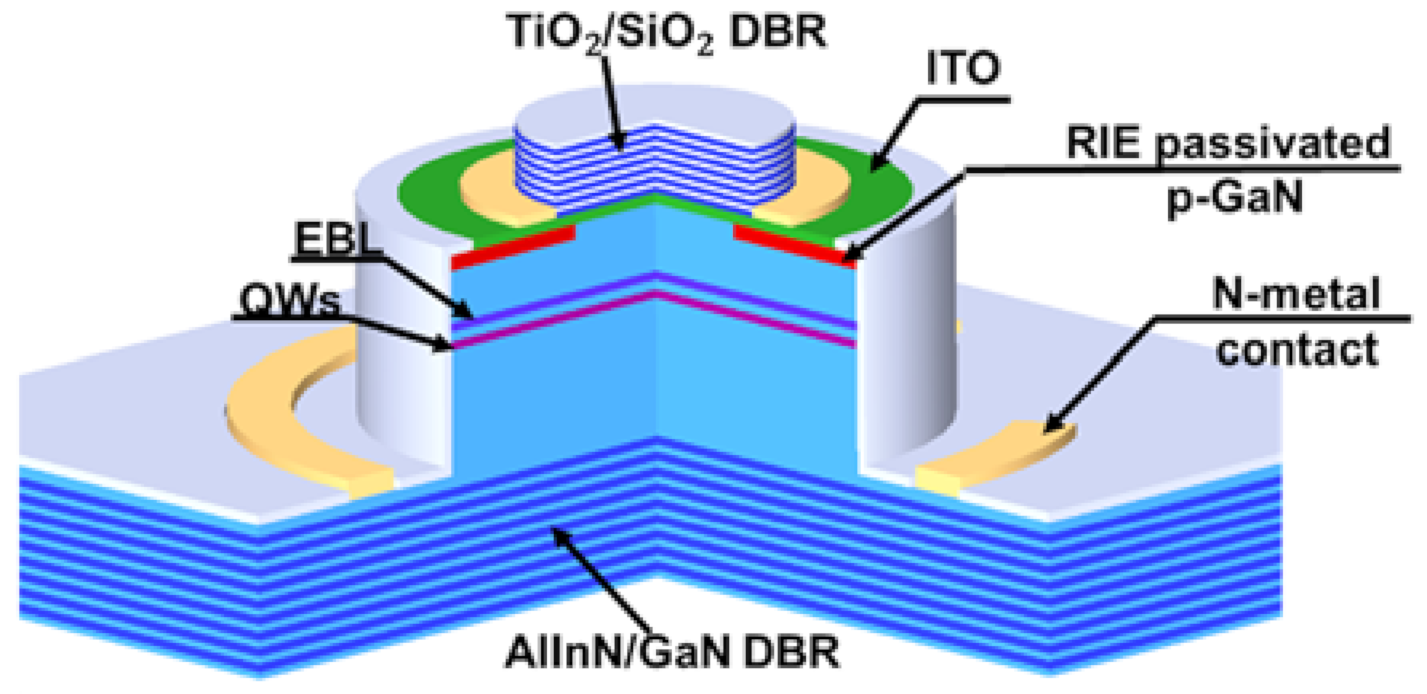


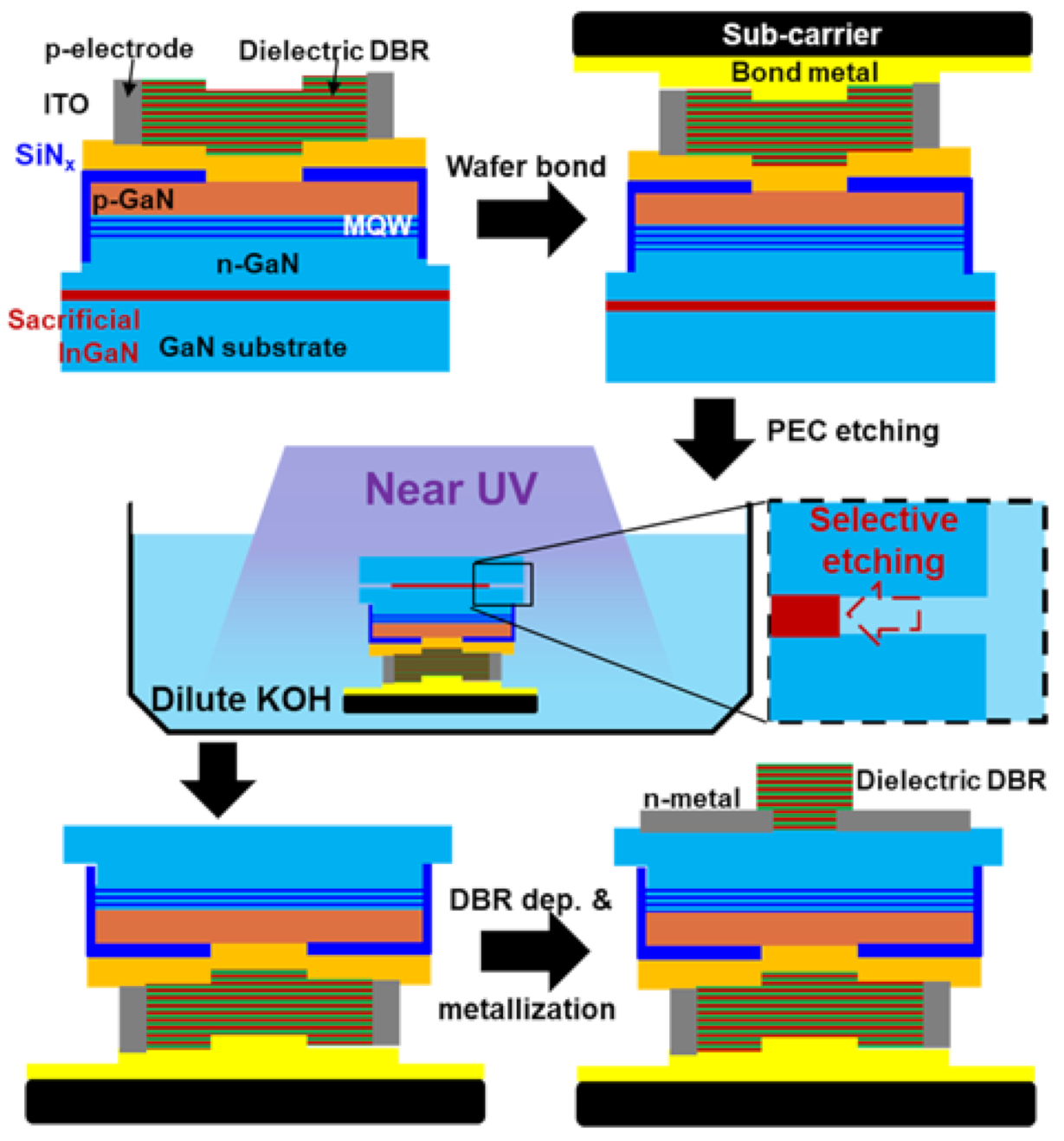


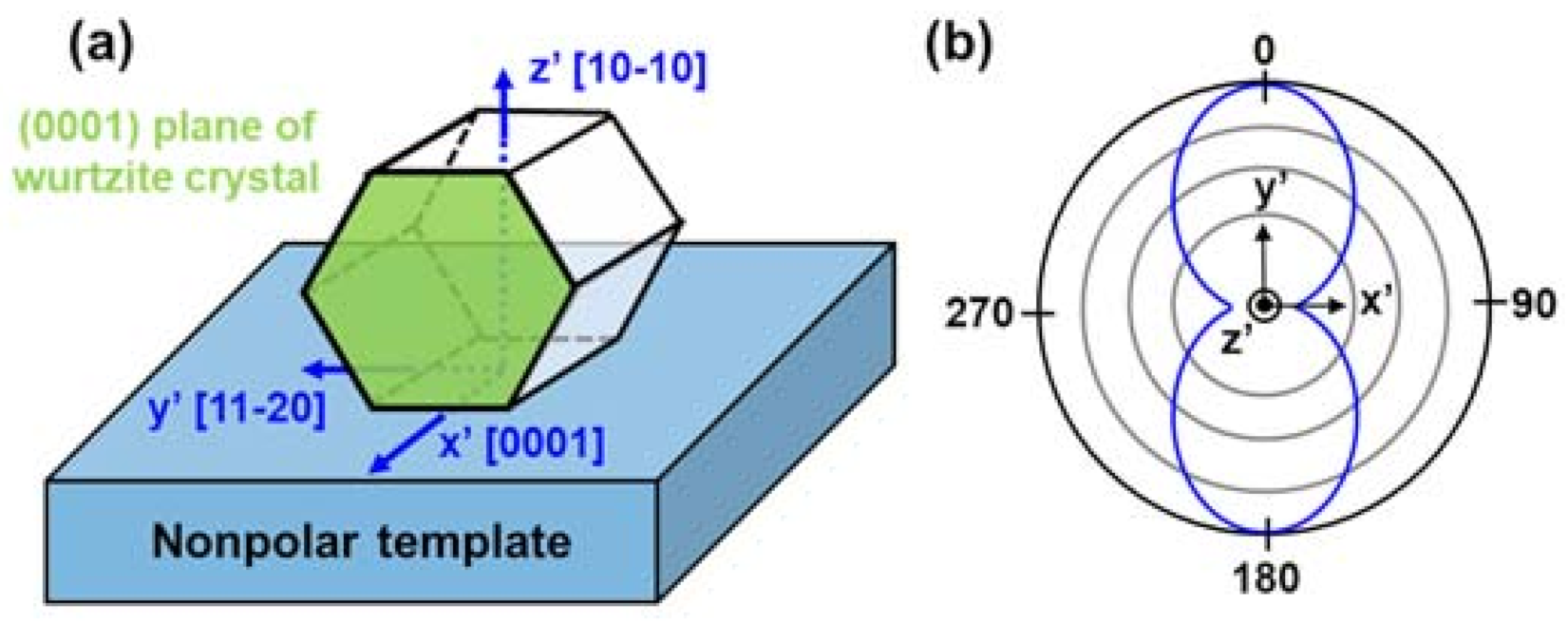
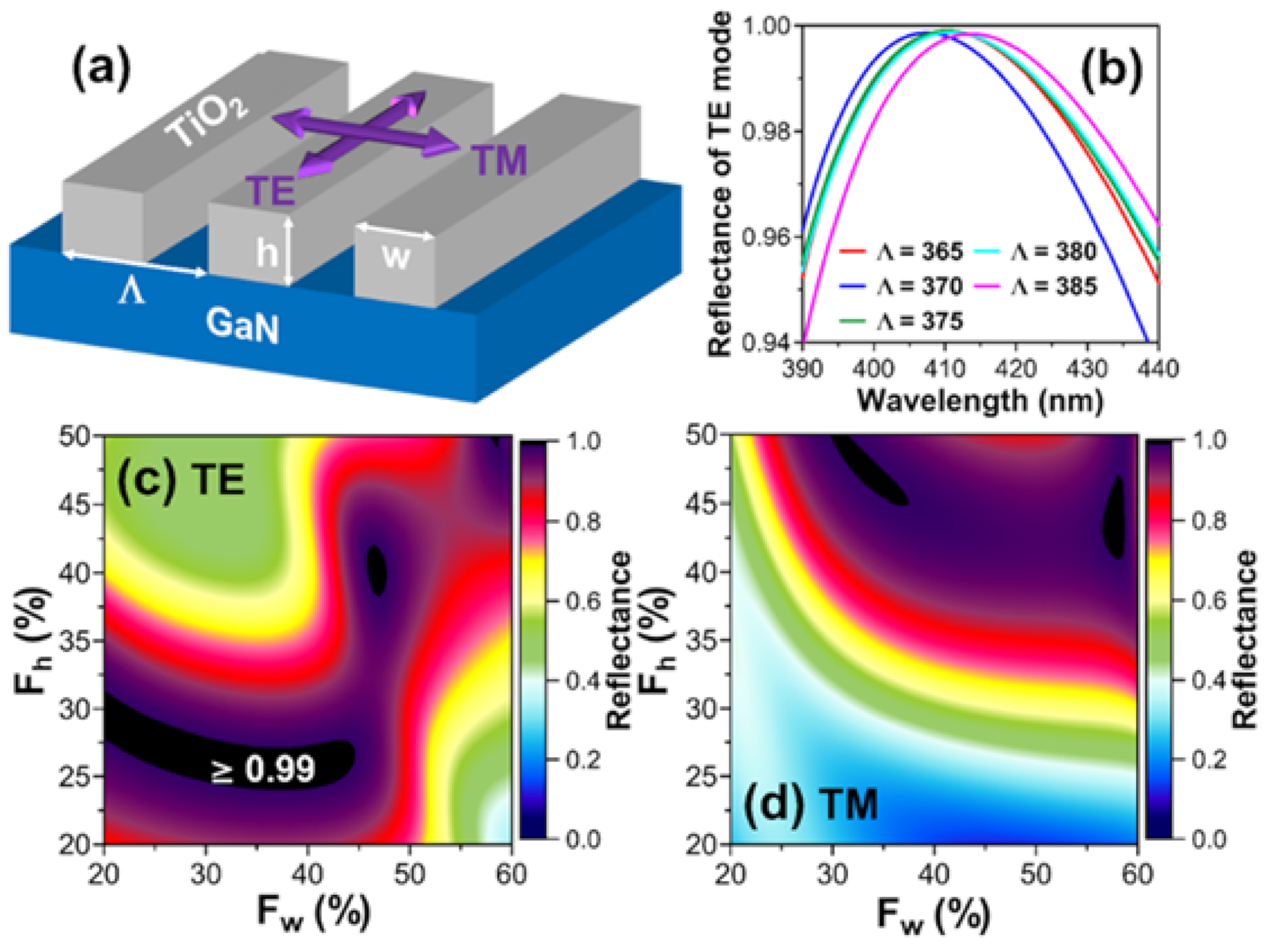
| AlN | GaN | InN | |
|---|---|---|---|
| a0 () | 3.112 | 3.186 | 3.548 |
| c0 () | 4.982 | 5.186 | 5.703 |
| εx to GaN (%) | 2.47 | -- | −10.20 |
| εz to GaN (%) | 4.07 | -- | −9.07 |
| Psp (C/m2) | −0.081 | −0.029 | −0.032 |
| e31 (C/m2) | 1.46 | 0.73 | 0.97 |
| e33 (C/m2) | −0.60 | −0.49 | −0.57 |
| C13 (GPa) | 108 | 103 | 92 |
| C33 (GPa) | 373 | 405 | 224 |
| me/m0 | 0.4 | 0.2 | 0.11 |
| Affiliation | Reflectors | Cavity Length | Carrier Aperture | Jth (kA/cm2) | Pmax (mW) | Operating Condition | Ref. |
|---|---|---|---|---|---|---|---|
| NCTU, Hsinchu, Taiwan | Hybrid (AlN/GaN) | 5 λ | Flat SiO2 | 10.6 | 0.9 | CW/RT | [12,27,28] |
| Dual dielectric | 2.5 λ | 8.9 | 0.02 | Pulse/350 K | [29,30] | ||
| Dielectric + HCG | 5 λ | 11.2 | 0.007 | Pulse/RT | [31] | ||
| Nichia Corp., Tokushima, Japan | Dual dielectric | 7 λ | Flat SiO2 | 1.9 | 0.7 | CW/RT | [11,32,33] |
| Sony Corp., Kanagawa, Japan | Dual dielectric | 10 λ | Flat SiO2 | 15.9 | 0.9 | CW/RT | [35,36] |
| ~150 μm | Implanted B | 4.2 | 0.3 | [37,38] | |||
| Panasonic Corp. Kyoto, Japan | Dual dielectric | 30 λ | Flat SiO2 | 0.5 | 0.003 | CW/RT | [34] |
| EPFL, Lausanne, Swiss | Hybrid (AlInN/GaN) | 7 λ | RIE passivation | 139.3 | 0.35 | CW/RT | [21] |
| Meijo Univ. & Nagoya Univ., Nagoya, Japan | Hybrid (AlInN/GaN) | 1.5 λ ~ 4.5 λ | Flat SiO2 | 4.0 | 0.88 | CW/RT | [22,23,24,25,26] |
| Stanley Electric Corp. Tokyo, Japan | Hybrid (AlInN/GaN) | 4.5 λ~10 λ | Buried SiO2 | 11.6 | 15.7 | CW/RT | [39,40,41,42] |
| 10 λ | RIE passivation | 21.3 | 23.7 | CW/RT | [43] | ||
| Univ. of California, Santa Barbara, CA, USA | Dual dielectric | 7.5 λ | Flat SiNx | 90.9 | 0.019 | Pulse/RT | [44] |
| 7 λ | Implanted Al | 17.7 | 0.012 | [45] | |||
| 7 λ | Ta2O5 with TJ | 3.5 | 0.55 | [46] | |||
| 7 λ | PEC air-gap | 22.0 | 0.18 | [47,48] | |||
| 6.5 λ ~ 23 λ | Implanted Al | 9.7 | 0.319 | [49,50] | |||
| Univ. of New Mexico Albuquerque, NM, USA | Hybrid (GaN/ nano-porous GaN) | 8 λ | Implanted Al with TJ | 20.0 | 1.5 | Pulse/RT | [51] |
| Xiamen Univ., Xiamen, China | Dual dielectrics | NA | Flat SiO2 | 1.2 | 0.5 | CW/RT | [52] |
| 2.5 λ | Buried SiO2 | 9.1 | 0.2 | [53] | |||
| * 850 nm | Dual epitaxial | NA | AlxOy oxide | 0.9 | 9 | CW/RT | [54] |
| 940 nm | NA | 1.7 | 7.7 | [55] | |||
| 980 nm | 0.5 λ | 0.8 | 11 | [56] | |||
| 1310 nm | 2.5 λ | TJ | 3.1 | 3.6 | [57] | ||
| 1550 nm | Dual dielectric | 2.5 λ | 3.5 | 3.0 | [58] |
| Dielectric DBR | SiO2 | SiNx | Ta2O5 | ZrO2 | TiO2 | Nb2O5 |
|---|---|---|---|---|---|---|
| n at 420 nm | 1.468 | 1.956 | 2.228 | 2.211 | 2.294 | 2.501 |
| Epitaxial DBR | GaN | Al0.6Ga0.4N | Al0.82In0.18N | AlN | ||
| n at 420 nm | 2.545 | 2.255 | 2.135 | 2.096 | ||
| Λ (nm) | Fw (%) | Fh (%) |
|---|---|---|
| 365 | 18.0 | 31.5 |
| 370 | 21.0 | 29.5 |
| 375 | 29.0 | 26.5 |
| 380 | 31.5 | 25.5 |
| 385 | 34.5 | 25.0 |
Publisher’s Note: MDPI stays neutral with regard to jurisdictional claims in published maps and institutional affiliations. |
© 2021 by the authors. Licensee MDPI, Basel, Switzerland. This article is an open access article distributed under the terms and conditions of the Creative Commons Attribution (CC BY) license (https://creativecommons.org/licenses/by/4.0/).
Share and Cite
Huang, C.-Y.; Hong, K.-B.; Huang, Z.-T.; Hsieh, W.-H.; Huang, W.-H.; Lu, T.-C. Challenges and Advancement of Blue III-Nitride Vertical-Cavity Surface-Emitting Lasers. Micromachines 2021, 12, 676. https://doi.org/10.3390/mi12060676
Huang C-Y, Hong K-B, Huang Z-T, Hsieh W-H, Huang W-H, Lu T-C. Challenges and Advancement of Blue III-Nitride Vertical-Cavity Surface-Emitting Lasers. Micromachines. 2021; 12(6):676. https://doi.org/10.3390/mi12060676
Chicago/Turabian StyleHuang, Chia-Yen, Kuo-Bin Hong, Zhen-Ting Huang, Wen-Hsuan Hsieh, Wei-Hao Huang, and Tien-Chang Lu. 2021. "Challenges and Advancement of Blue III-Nitride Vertical-Cavity Surface-Emitting Lasers" Micromachines 12, no. 6: 676. https://doi.org/10.3390/mi12060676
APA StyleHuang, C.-Y., Hong, K.-B., Huang, Z.-T., Hsieh, W.-H., Huang, W.-H., & Lu, T.-C. (2021). Challenges and Advancement of Blue III-Nitride Vertical-Cavity Surface-Emitting Lasers. Micromachines, 12(6), 676. https://doi.org/10.3390/mi12060676







